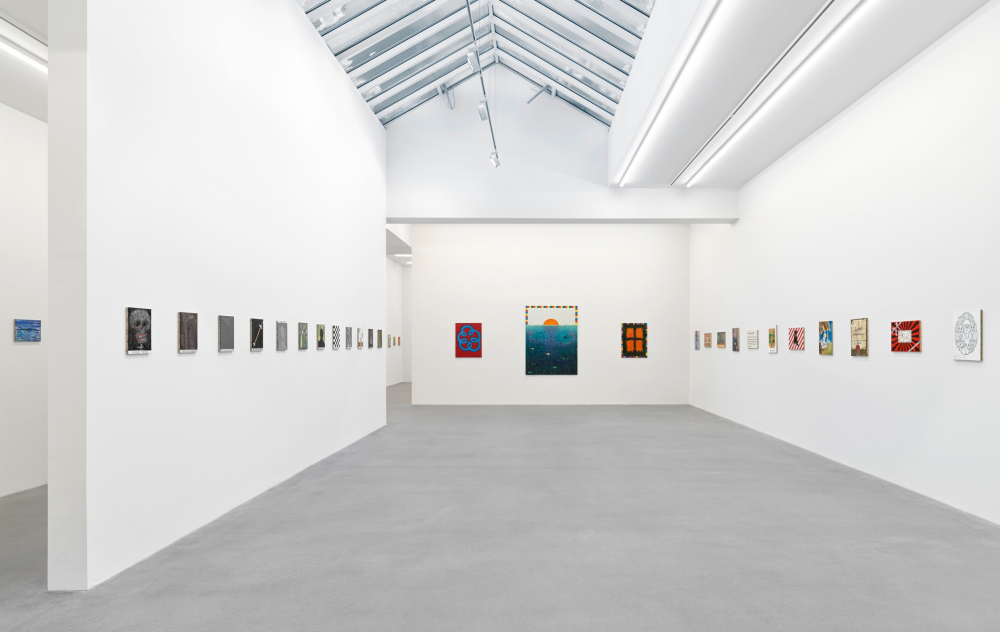Jean-Frédéric Schnyder — Œl auf Leinwand
Galerie Eva Presenhuber is pleased to present ŒL AUF LEINWAND, its ninth solo exhibition with the Swiss artist Jean-Frédéric Schnyder. Two new publications accompany the exhibition: Œl auf Leinwand: 1982 - 2023 and Objekte + Skulpturen: 1967 - 2023.
The 67 paintings on display and the 162-part series Billige Bilder (“Cheap Pictures”) provide an overview of Schnyder’s extensive painterly oeuvre from 1982 to the present day and reveal his most important traits, namely seriality, the tension between similarity and dissimilarity, as well as a great interest in the everyday ordinary. They are permeated by recognizable motifs and concepts, such as landscapes, letter paintings and still lifes. In the juxtaposition of paintings such as 3 Blumen, which shows three flowers in a coarse, pixel-like colour grid, and work groups, such as Abend am Zugersee, the question of a body of work arises. The answer lies in Schnyder’s absolute and consistent interest in the subject and in painting itself.
When Schnyder exhibited his first paintings in the 1970s, these works, which appeared new alongside his previously predominantly sculptural approach and bore titles such as Stilleben, Akt or Landschaft, were interpreted as a conceptual approach. Schnyder’s interest, however, is focussed on precisely what he names in the titles of his works, namely the most important motifs in the history of painting. In the decades that followed, he created many different series of paintings with a wide variety of motifs and approaches. He turned to still lifes, painted vegetables or fabric softener bottles with meticulous precision and explored styles that we believe to be familiar from the history of painting. However, this appropriation is not to be understood as ironic appropriation in the Pop sense, but rather as a serious exploration and experimentation of the everyday, which is never too insignificant to become part of the work. It is in this sense that one of Schnyder’s most famous distancing from irony can be understood: “I am not ironic, the others say that about me.”
For example, the painterly depiction of the Kreuzung Ritter-Lindenstrasse may appear everyday, but this is only the case on the surface. The picture was created out of a great interest in the scene itself, as well as in its painterly depiction. Like many of his other paintings, Schnyder painted it en plein air at the easel. Nothing about it is accidental. The person with the bright yellow hair and red coat is passing through the scene at the exact moment it is captured - while the tail light of the passing car is still visible.
Where one recognizes the painter’s meticulous diligence in the studio or at the easel in this way of working, one also discovers an encyclopaedic approach to subject and process. It is precisely this exactitude and completeness with which he captures his motifs that gives rise to an unironic ambiguity: His gaze brings out something repressed, like the black sheep in the angel’s arms in Engelchen. The interpretation of the painting seems obvious, but Schnyder is more concerned with the possibility of realising the motif with the greatest possible painterly consistency. A white sheep in front of a white robe would hardly be recognizable and would not do justice to the medium of painting. Schnyder thus emphasises this difference between the pictorial and the symbolic order.
Schnyder, as someone who is more interested in technical solutions than in theory, creates primal forms on the canvas whose physicality is the colour. In a fascinating way, he transfers theoretical technical considerations directly onto the canvas. The Billige Bilder series also represents a consistent point in his work. The individual pictures are the textiles with which Schnyder cleaned his brushes. Painting is what emerges from painting, from the artist’s work. This clear and tautological clarity forms Schnyder’s sensually tangible theory of painting.
Tillmann Severin
Jean-Frédéric Schnyder was born in 1945 in Basel, CH. He lives and works in Zug, CH. His first solo exhibition organized by Eva Presenhuber at Galerie Walcheturm in Zurich took place in 1993, followed by another in 1996. A solo exhibition at Galerie Hauser & Wirth & Presenhuber took place in 1999. At Galerie Eva Presenhuber, Zurich, Schnyder has had solo exhibitions in 2004, 2010, and 2019. In 2018, Eva Presenhuber, New York showed the body of works Am Thunersee in a solo exhibition. Schnyder contributed to the La Biennale di Venezia, Venice, IT (2013); La Biennale Paris, Paris, FR (1985 and 1971); Documenta 5, Kassel, DE (1972); and Documenta 7, Kassel, DE (1982). Recent solo exhibitions have taken place in international institutions including Secession Vienna, Vienna, AT (2022), Kunsthalle Bern, Bern, CH (2022), Kunsthaus Zürich, Zurich, CH (2014); Kunstmuseum Bern, Bern, CH (2013); Ca’ Corner della Regina Venice, Venice, IT (2013); Le Consortium, Dijon, FR (2012); and The Swiss Institute / Contemporary Art, New York, US (2011). Group exhibitions in major museums include Zeitgeist, MAMCO – Musée d´art moderne et contemporain, Geneve, CH (2017); Das Fotobuch und seine Autoren, Swiss National Library, Bern, CH (2015); Drawings from the Ringier Collection Chapter I, Villa Flora Winterthur – Sammlung Hahnloser, Winterthur, CH (2015); and Ferdinand Hodler, Jean-Frédéric Schnyder, Kunsthaus Zürich, Zurich, CH (2014).
Künstler:innen
| Details | Name | Portrait |
|---|---|---|
| Jean-Frédéric Schnyder |
Institutionen
| Titel | Land | Ort | Details |
|---|---|---|---|
| Galerie Eva Presenhuber AG | Schweiz
|
Zürich
|
Schweiz
Zürich
|
